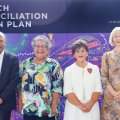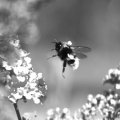A University of Queensland survey of the southern Milky Way has revealed some mysterious objects and structures previously undetected by radio astronomers in our Galaxy.
The survey images, which can be viewed on the World Wide Web, have been captured by Dr Roy Duncan of the University's Physics Department.
Radio astronomy is a way to explore the Universe by detecting radio emissions from a variety of celestial objects, such as the Sun, planets, pulsars and quasars.
Dr Duncan discovered the structures while using the Parkes radio telescope on a jointly supervised PhD project, involving both the University and CSIRO's Australia Telescope National Facility (ATNF).
His PhD, awarded last year, was the first jointly supervised by the ATNF and any Queensland institution.
Three further University of Queensland PhD students - Marc Elmouttie, Boris Babic and Scott Gordon - are progressing with studies of other galaxies and clusters of galaxies in the UQ/ATNF program, all co-supervised by Dr Keith Jones.
'One of the great advantages of radio astronomy is that radio waves are not obscured by the interstellar dust and clouds that restrict views by optical telescopes,' Dr Duncan said.
Dr Duncan, a departmental research assistant, surveyed a strip of about a third of the Milky Way, some 20 full Moon widths across, using the 64 metre diameter Parkes radio dish and associated equipment.
'The survey has revealed many new objects and features, raising many new questions. This kind of work gives researchers a better understanding of the structure and dynamics of galaxies in general, and our own Galaxy in particular,' he said.
From the project, images of the radio emission were produced - essentially radio 'photographs.' The project also produced information on polarization characteristics, allowing Dr Duncan to get a better idea of the physics of the new objects and features discovered.
Dr Duncan said the pseudo-colour pictures showed bright objects (those coloured yellow and red) which were either regions of hot, ionized hydrogen gas or supernova remnants (the remains of exploded stars). These bright objects have been known for many years, although the survey images reveal the full extent of the objects and their relation to the more general radio emission.
Of more scientific interest were fainter features (coloured light blue and purple), revealing previously unknown objects and structures.
A number of very active ionized regions have been identified from this work. One such complex seems to be ejecting great arcs of hot gas to distances of 700 light-years above the plane of the Galaxy, which then falls back towards the disk. In other areas, several bright complexes are seen to produce faint outflows of hot, low density gas which stretch many hundreds of light-years towards the halo of our Galaxy.
'This discovery is particularly interesting. The existence of such chimney-like structures has been theorized for some years; this is the first clear detection,' Dr Duncan said.
Twenty-two new supernova remnants have been identified from the survey images. These are large objects, ranging in size from about one half to 35 times the diameter of Earth's full Moon.
Dr Duncan is conducting follow-up work, using both the Parkes radio telescope and the Australia Telescope Compact Array.
'We have just completed high-resolution imaging of many newly-discovered supernova remnants, using both the ATCA and the Very Large Array in New Mexico, ' he said. Results from this work are still being analysed.
The project has already resulted in eight scientific papers and three presentations to conferences.
Dr Duncan became interested in astronomy at a young age and joined a local astronomy club, the Southern Astronomical Society, in 1986.
He completed a bachelor of science at the University of Queensland from 1989 to 1991. The next year, Dr Duncan undertook science honours in ionospheric physics, supervised by Professor David Whitehead, before working with the ATNF as part of their summer vacation scholarship program.
Dr Duncan said he hoped the southern Milky Way survey would be an excellent resource for southern Galactic studies for many years to come.
"Over the next few years, several other sensitive surveys of our Galaxy will be observed in Australia, at both optical and radio wavelengths. The prospects for comparison and collaboration with these other studies are excellent, and should produce some interesting results," he said.
The Internet site for the galactic images is at: http://www.atnf.csiro.au/people/duncan
For further information, contact Dr Duncan, telephone 07 3365 3424, email: duncan@physics.uq.edu.au



